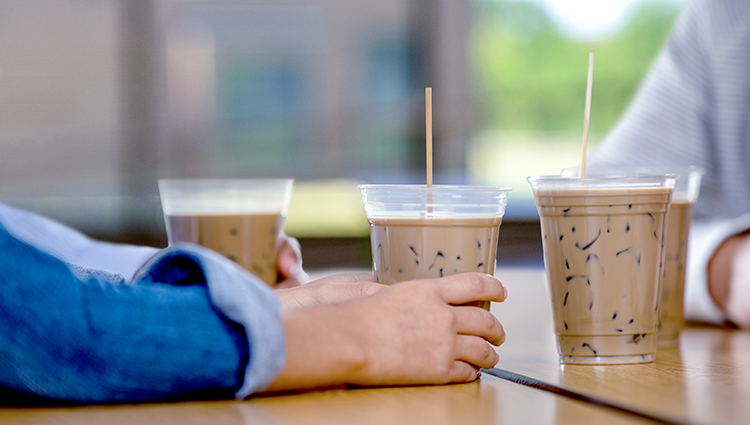Coffee in Schools: What’s all the Buzz?
As school nutrition operators strive to compete with outside food and beverage establishments, coffee bars have steadily grown in popularity across the country. High school students can often be found hanging out at their local coffee shop, so why not keep them on campus to enjoy their favorite beverages? Read on to learn about the health benefits of coffee, the latest guidelines on caffeine and adolescents, and how to create a healthier drink with your current labor and staff!
Health Benefits of Coffee
While there may be concerns with the ingredients added to coffee beverages, the coffee bean itself is a nutrient powerhouse!
Coffee contains essential nutrients including riboflavin, pantothenic acid, manganese, potassium, magnesium and niacin. It is also rich in disease-fighting antioxidants and phytochemicals, which help lower the risk of different cancers, stroke, Alzheimer’s disease, and Type 2 diabetes (1, 2, 3, 4, 5).
With that said, drinking coffee just might improve your health!!
Milk in Coffee Drinks
Milk contains 13 essential nutrients, yet the majority of adolescents fall short meeting the recommended number of servings (6, 7). As noted earlier, the ingredients added to coffee can be of concern, so to promote the best nutrition, make coffee drinks with low-fat or skim milk to provide customers with the calcium they need along with the flavor they crave.
Is Coffee for Teens Safe?
Coffee definitely can be part of a healthy diet, but is it safe for teens? Coffee itself is healthy, but it is important to be mindful of the caffeine content of coffee, as well as added sugar often found in coffee beverages.
Caffeine Recommendations
The American Academy of Pediatrics advises against caffeine consumption for children under 12 years old and against any energy drinks for all ages. For 12-18 year olds, it is recommended that caffeine is limited to 100 mg daily (8). At high doses, caffeine can increase anxiety, disrupt sleep, and cause gastrointestinal distress. Extremely high doses of caffeine can even be toxic (9).
Caffeine can interrupt a teenager’s sleep, so drinking coffee drinks during school hours is better than later in the evening (9).
With that said, coffee should only be served to high school students, and caffeine should be limited. One cup of coffee contains approximately 95 mg of caffeine, so when considering the size of drinks to offer to students, be sure to keep the coffee portion of the drink to 1 cup, or 8 ounces (10). For instant coffee, this is about 1 teaspoon dry.
When comparing coffee drinks to other drinks that contain caffeine, such as soda and energy drinks, there are clear advantages. Antioxidant-rich coffee paired with nutrient-dense milk provides students with a healthful beverage option that is much better than nutrient-poor soda and energy drinks.
Caffeine Benefits
While caffeine does need to be restricted, there are also benefits. Caffeine consumption is correlated with improved mood and brain function, increased alertness, and enhanced exercise performance. Caffeine may also help boost metabolism, promoting a healthy weight (9, 11).
Sugar Recommendations
The American Heart Association recommends adolescents limit added sugars to 24 grams (~6 teaspoons) per day. American children and teens currently consume triple the recommended amount (12).
Coffee is bitter, so you won’t find many kids drinking it black. Consider making drinks and flavored syrups from scratch to control the sugar content and ingredients. Contact your Dairy MAX representative to get a copy of their new recipes made with real sugar!
Benefits of Adding Coffee to School Menus
Let’s face it, if our students aren’t drinking coffee with us, then they are visiting their favorite local coffee shop to get their caffeine fix. We have the opportunity to offer them their favorite beverage, prepared in a healthier way with wholesome milk, lower caffeine, and reduced sugar – all the while still delivering on flavor and presentation!
Consider including milk-based coffee drinks as part of the reimbursable meal. This can help increase participation, meaning more revenue for your school nutrition program! Further, if your school allows off-campus dining, serving coffee drinks is a great way to incentivize them not to leave.
Equipment Considerations
Some schools have coffee bars with fancy espresso machines that make everything for you. While these machines are great, they are expensive. If an espresso machine is not in your budget, don’t worry! You can still make delicious drinks using instant coffee! While a milk frother is still recommended, a simple microwave can just as effectively do the trick.
Dairy MAX’s signature Dalgona coffee recipes require a hand or stand mixer to achieve the desired whipped consistency.
If your school plans on making frozen drinks, consider buying a commercial blender to ensure the best quality.
Labor Considerations
A stand alone coffee bar requires another kitchen crew, but if you serve coffee drinks from your current lines, minimal extra labor is required.
Dairy MAX’s coffee drink recipes can be prepared in advance, then warmed or assembled as needed. Cold brew beverages can be poured before service and placed on the line. Even hot drinks can be pre-portioned into cups and then warmed in microwave-safe containers upon purchase.
Be sure to cross-train multiple employees on how to prepare coffee drinks, so there are no issues if someone is out.
Well…are you convinced? Are you ready to serve coffee beverages at your school? Contact your local Dairy MAX representative today!
Sources:[1]
- https://pubmed.ncbi.nlm.nih.gov/28675917/
- https://pubmed.ncbi.nlm.nih.gov/29474816/
- https://pubmed.ncbi.nlm.nih.gov/28288025/
- https://pubmed.ncbi.nlm.nih.gov/28589997/
- https://www.nejm.org/doi/10.1056/NEJMra1816604?url_ver=Z39.88-2003&rfr_id=ori%3Arid%3Acrossref.org&rfr_dat=cr_pub++0pubmed
- https://www.dairymax.org/sites/default/files/Science%20Summary_Milk%20and%20Health_06%2001%2018_FINAL.pdf
- https://www.dietaryguidelines.gov/sites/default/files/2021-03/Dietary_Guidelines_for_Americans-2020-2025.pdf
- https://www.aacap.org/AACAP/Families_and_Youth/Facts_for_Families/FFF-Guide/Caffeine_and_Children-131.aspx
- https://www.sciencedirect.com/science/article/pii/S0149763416300690?via%3Dihub
- https://fdc.nal.usda.gov/fdc-app.html#/food-details/171890/nutrients
- https://pubmed.ncbi.nlm.nih.gov/30977054/
- https://www.heart.org/en/news/2018/05/01/kids-and-added-sugars-how-much-is-too-much




